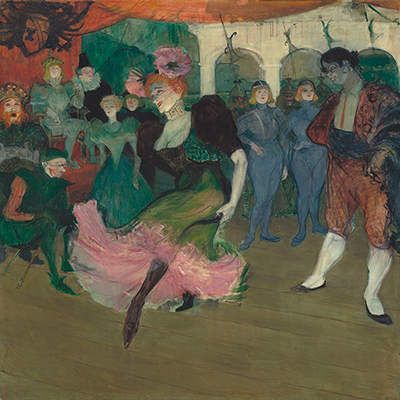One of the great ironies of Marcelle Lender Dancing in the Bolero in Chilperic by Henri de Toulouse-Lautrec is that Henri was infatuated with Marcelle but she loathed him. This beautiful and famous homage to a women was totally unappreciated by the subject.
Toulouse-Lautrec loved theatre and dance. Not necessarily the actual productions but the performers. There is nothing overtly sexual about Henri's interest in Marcelle. He comes across as a connoisseur of the human form and its suppleness. It was the athleticism of dance and theatre that appealed to Henri. He was most taken with Marcelle Lander's spine. It's therefore striking that Marcelle is front on in the painting "Marcelle Lender Dancing in the Bolero in Chilperic". In the painting, one of the focus points is Marcelle's ample bust. The colours in the painting are fairly muted but for the white. Marcelle's bust and arms and King Chilpéric's stockings are white. Like lights at dusk, they draw the eye towards them.
Marcelle Lender Dancing the Bolero in Chilpéric is a substantial oil on canvas painting. It measures 145 x 149cm unframed. The painting is owned by the US based Whitney family and is exhibited at Washington's National Gallery of Art. Henri de Toulouse-Lautrec was born into an aristocratic French family in 1864. He was not a healthy child, something rather scandalously attributed to his family's history of inbreeding. Not much suited to an outdoors life, Henri turned to art. As a young man he went to Paris to study art under the portrait painter Léon Bonnat. He spent the better part of the late 19th and early 20th centuries living and painting in Paris, befriending and exhibiting with Emile Bernard and Vincent van Gogh.
It was also during this time that he became drawn to the theatre and dance halls of Paris. Much as these places were enjoyed by affluent Parisians, there was something vague downmarket about the performances and their performers. It was that anti-establishment, bohemian aspect that Henri de Toulouse-Lautrec particularly enjoyed.
Henri was taken with various performers and dancers over the years. They tended to be short, fleeting, intense and unfulfilled. Marcelle Lender performed in Hervé's Chilpéric for just three months in 1895 at the Théâtre des Variétés. Henri had met her previously but he managed to attend the opera 20 times in its three month run. Often he appeared at the start of the second act to see Marcelle dance Bolero. He sketched while she danced. The result was six lithohgraphs and two paintings including Marcelle Lender Dancing in the Bolero in Chilperic.
The painting is done from the perspective of an audience member. Henri de Toulouse-Lautrec's admiration of Marcelle's back is reinforced by the way the male character in the painting, King Chilperic, so overtly admires her from behind. The suggestion is it's the dancer's back and its very sinuosity he is staring at.




